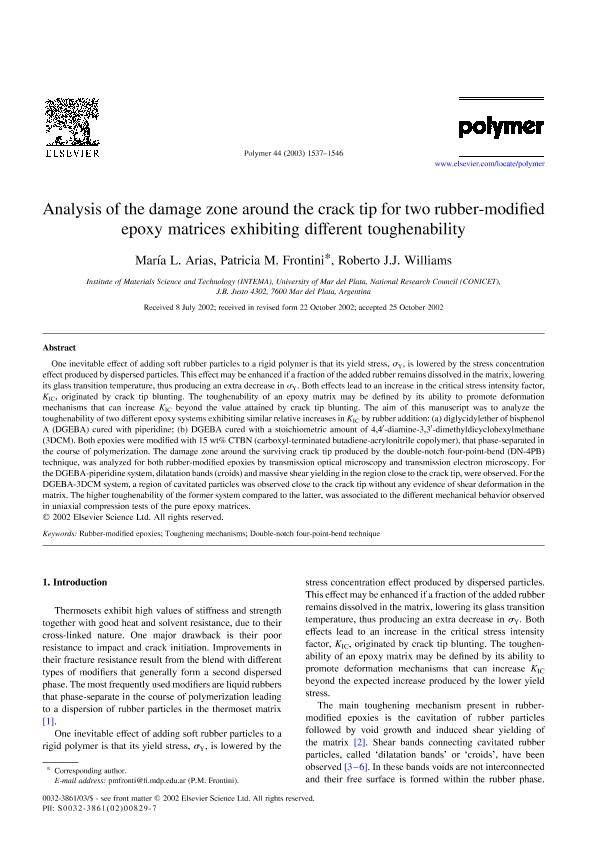Mostrar el registro sencillo del ítem
dc.contributor.author
Franco Arias, Lina Maria

dc.contributor.author
Frontini, Patricia Maria

dc.contributor.author
Williams, Roberto Juan Jose

dc.date.available
2019-05-23T22:19:27Z
dc.date.issued
2003-02
dc.identifier.citation
Franco Arias, Lina Maria; Frontini, Patricia Maria; Williams, Roberto Juan Jose; Analysis of the damage zone around the crack tip for two rubber-modified epoxy matrices exhibiting different toughenability; Elsevier; Polymer; 44; 5; 2-2003; 1537-1546
dc.identifier.issn
0032-3861
dc.identifier.uri
http://hdl.handle.net/11336/77001
dc.description.abstract
One inevitable effect of adding soft rubber particles to a rigid polymer is that its yield stress, σY, is lowered by the stress concentration effect produced by dispersed particles. This effect may be enhanced if a fraction of the added rubber remains dissolved in the matrix, lowering its glass transition temperature, thus producing an extra decrease in σY. Both effects lead to an increase in the critical stress intensity factor, KIC, originated by crack tip blunting. The toughenability of an epoxy matrix may be defined by its ability to promote deformation mechanisms that can increase KIC beyond the value attained by crack tip blunting. The aim of this manuscript was to analyze the toughenability of two different epoxy systems exhibiting similar relative increases in KIC by rubber addition: (a) diglycidylether of bisphenol A (DGEBA) cured with piperidine; (b) DGEBA cured with a stoichiometric amount of 4,4′-diamine-3,3′-dimethyldicyclohexylmethane (3DCM). Both epoxies were modified with 15 wt% CTBN (carboxyl-terminated butadiene-acrylonitrile copolymer), that phase-separated in the course of polymerization. The damage zone around the surviving crack tip produced by the double-notch four-point-bend (DN-4PB) technique, was analyzed for both rubber-modified epoxies by transmission optical microscopy and transmission electron microscopy. For the DGEBA-piperidine system, dilatation bands (croids) and massive shear yielding in the region close to the crack tip, were observed. For the DGEBA-3DCM system, a region of cavitated particles was observed close to the crack tip without any evidence of shear deformation in the matrix. The higher toughenability of the former system compared to the latter, was associated to the different mechanical behavior observed in uniaxial compression tests of the pure epoxy matrices.
dc.format
application/pdf
dc.language.iso
eng
dc.publisher
Elsevier

dc.rights
info:eu-repo/semantics/openAccess
dc.rights.uri
https://creativecommons.org/licenses/by-nc-nd/2.5/ar/
dc.subject
Double-Notch Four-Point-Bend Technique
dc.subject
Rubber-Modified Epoxies
dc.subject
Toughening Mechanisms
dc.subject.classification
Recubrimientos y Películas

dc.subject.classification
Ingeniería de los Materiales

dc.subject.classification
INGENIERÍAS Y TECNOLOGÍAS

dc.subject.classification
Físico-Química, Ciencia de los Polímeros, Electroquímica

dc.subject.classification
Ciencias Químicas

dc.subject.classification
CIENCIAS NATURALES Y EXACTAS

dc.title
Analysis of the damage zone around the crack tip for two rubber-modified epoxy matrices exhibiting different toughenability
dc.type
info:eu-repo/semantics/article
dc.type
info:ar-repo/semantics/artículo
dc.type
info:eu-repo/semantics/publishedVersion
dc.date.updated
2019-05-15T16:44:42Z
dc.journal.volume
44
dc.journal.number
5
dc.journal.pagination
1537-1546
dc.journal.pais
Países Bajos

dc.journal.ciudad
Amsterdam
dc.description.fil
Fil: Franco Arias, Lina Maria. Consejo Nacional de Investigaciones Científicas y Técnicas. Oficina de Coordinación Administrativa Ciudad Universitaria. Instituto de Física del Plasma. Universidad de Buenos Aires. Facultad de Ciencias Exactas y Naturales. Instituto de Física del Plasma; Argentina
dc.description.fil
Fil: Frontini, Patricia Maria. Consejo Nacional de Investigaciones Científicas y Técnicas. Centro Científico Tecnológico Conicet - Mar del Plata. Instituto de Investigaciones en Ciencia y Tecnología de Materiales. Universidad Nacional de Mar del Plata. Facultad de Ingeniería. Instituto de Investigaciones en Ciencia y Tecnología de Materiales; Argentina
dc.description.fil
Fil: Williams, Roberto Juan Jose. Consejo Nacional de Investigaciones Científicas y Técnicas. Centro Científico Tecnológico Conicet - Mar del Plata. Instituto de Investigaciones en Ciencia y Tecnología de Materiales. Universidad Nacional de Mar del Plata. Facultad de Ingeniería. Instituto de Investigaciones en Ciencia y Tecnología de Materiales; Argentina
dc.journal.title
Polymer

dc.relation.alternativeid
info:eu-repo/semantics/altIdentifier/url/https://www.sciencedirect.com/science/article/pii/S0032386102008297
dc.relation.alternativeid
info:eu-repo/semantics/altIdentifier/doi/http://dx.doi.org/10.1016/S0032-3861(02)00829-7
Archivos asociados
